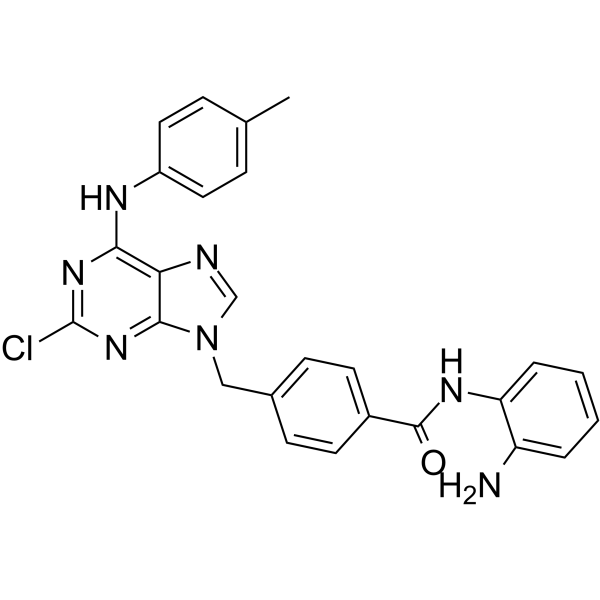HDAC1/2 and CDK2-IN-1
Modify Date: 2025-09-11 19:49:41

HDAC1/2 and CDK2-IN-1 structure
|
Common Name | HDAC1/2 and CDK2-IN-1 | ||
|---|---|---|---|---|
| CAS Number | 2418559-01-8 | Molecular Weight | 483.95 | |
| Density | N/A | Boiling Point | N/A | |
| Molecular Formula | C26H22ClN7O | Melting Point | N/A | |
| MSDS | N/A | Flash Point | N/A | |
Use of HDAC1/2 and CDK2-IN-1HDAC1/2 and CDK2-IN-1 (compound 14d) is a potent HDAC1, HDAC2 and CDK2 dual inhibitor, with IC50 values of 70.7, 23.1 and 0.80 μM, respectively. HDAC1/2 and CDK2-IN-1 can block the cell cycle and induce apoptosis. HDAC1/2 and CDK2-IN-1 exhibits desirable in vivo antitumor activity[1]. |
| Name | HDAC1/2 and CDK2-IN-1 |
|---|
| Description | HDAC1/2 and CDK2-IN-1 (compound 14d) is a potent HDAC1, HDAC2 and CDK2 dual inhibitor, with IC50 values of 70.7, 23.1 and 0.80 μM, respectively. HDAC1/2 and CDK2-IN-1 can block the cell cycle and induce apoptosis. HDAC1/2 and CDK2-IN-1 exhibits desirable in vivo antitumor activity[1]. |
|---|---|
| Related Catalog | |
| Target |
HDAC1:70.7 nM (IC50) HDAC2:23.1 nM (IC50) CDK2:0.80 nM (IC50) |
| In Vitro | HDAC1/2 and CDK2-IN-1 (compound 14d) shows excellent antiproliferative activities against H460, A375, HepG2, HCT116 and Hela cells with IC50 values of 1.59, 0.47, 0.86, 0.58 and 1.05 μM, respectively[1]. HDAC1/2 and CDK2-IN-1 (0.5 μM, 48 h) significantly inhibits the migration of H460 and A375 cells[1]. HDAC1/2 and CDK2-IN-1 (0-2 μM, 24 h) significantly blocks the cell cycle in the G2/M phase[1]. HDAC1/2 and CDK2-IN-1 (0-2 μM, 48 h) promotes cancer cell apoptosis in a dose-dependent manner[1]. HDAC1/2 and CDK2-IN-1 (1 μM, 12 h) inhibits CDK2 and HDAC activity, causing cancer cell death[1]. HDAC1/2 and CDK2-IN-1 (1 μM, 24 h) strongly increases ROS levels in A375 cells, causes cancer cell death by improving intracellular ROS levels[1]. Cell Cycle Analysis Cell Line: A375, HCT116, H460 and Hela cells[1] Concentration: 0, 0.5, 1, 2 μM Incubation Time: 24 h Result: Significantly blocked the cell cycle, induced a loss of G0/G1 phase cells and an increase of G2/M phase cells, led to an apparent accumulation of cells in G2/M phase at 0.5 μM (A375, the percentage from 13.70 to 57.03%; HCT116, from 27.46 to 76.99%; Hela, from 7.89% to 51.85%). Apoptosis Analysis Cell Line: A375, HCT116, H460 and Hela cell lines[1] Concentration: 0, 0.5, 1, 2 μM Incubation Time: 48 h Result: Promoted cancer cell apoptosis in a dose-dependent manner, with the apoptosis rates of 91.99% (A375), 89.60% (HCT116), 59.10% (H460), and 22.36% (Hela) respectively at the concentration of 2 μM. Immunofluorescence Cell Line: A375 cells[1] Concentration: 1 μM Incubation Time: 12 h Result: Significantly inhibited CDK2 and increased the acetylation level of histone H3, inhibited CDK2 and HDAC activity, causing cancer cell death. |
| In Vivo | HDAC1/2 and CDK2-IN-1 (BALB/c nude mice, 0-100 mg/kg, IP, once daily for 21 days) significantly inhibits the tumor growth[1]. HDAC1/2 and CDK2-IN-1 (compound 14d) (ICR mice; 4 mg/kg, IV; 20 mg/kg, IP) exhibits desirable pharmacokinetic properties[1]. Pharmacokinetic Parameters of HDAC1/2 and CDK2-IN-1 in male ICR mice[1]. Dose (mg/kg) 4 20 Administration IV IP T1/2 (h) 1.48 2.84 Tmax (h) 2 Cmax (ng/mL) 1360 AUC0-t (ng/mL*h) 2850 7240 MRT0-t (h) 0.563 4.54 CL (mL/(min/kg)) 23.3 F (%) 50.8 Animal Model: Male ICR mice (n = 9)[1] Dosage: 4 mg/kg (IV), 20 mg/kg (IP) Administration: IV, IP, once (Pharmacokinetic Analysis) Result: Exhibited desirable pharmacokinetic properties. Animal Model: BALB/c nude mice (5-6 weeks, HCT116 xenograft model)[1] Dosage: 0, 25, 50 and 100 mg/kg Administration: IP, once daily for 21 days Result: Significantly inhibited the tumor growth, the tumor growth inhibitions were 28%, 40% and 44% at doses of 25, 50 and 100 mg/kg, respectively. |
| References |
| Molecular Formula | C26H22ClN7O |
|---|---|
| Molecular Weight | 483.95 |
| InChIKey | XHELPOUKGPDRRH-UHFFFAOYSA-N |
| SMILES | Cc1ccc(Nc2nc(Cl)nc3c2ncn3Cc2ccc(C(=O)Nc3ccccc3N)cc2)cc1 |